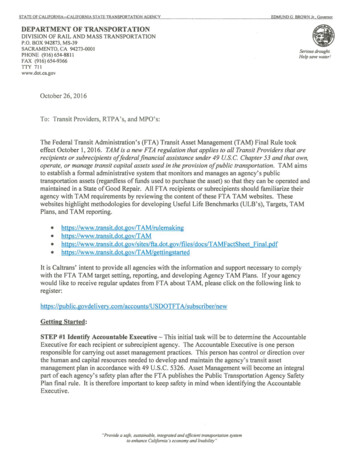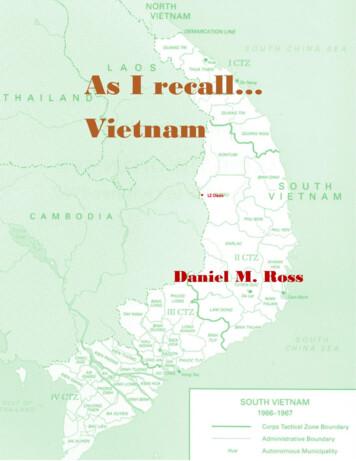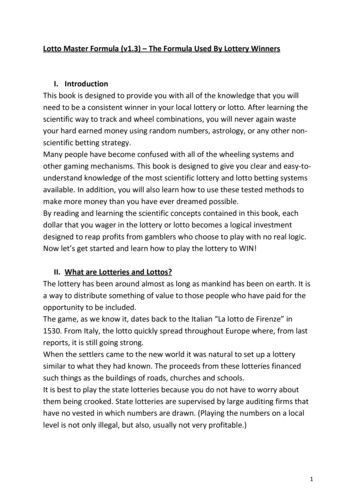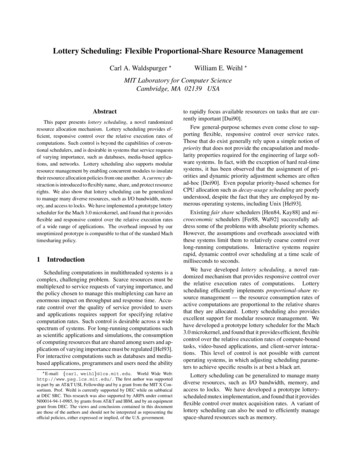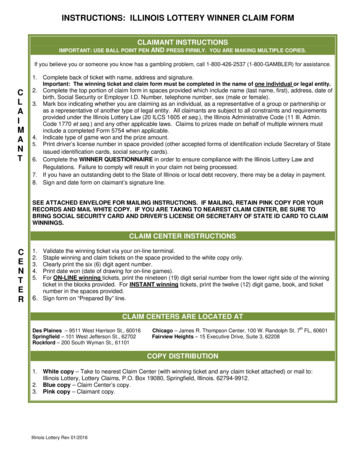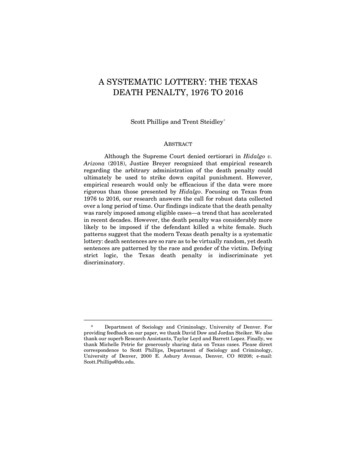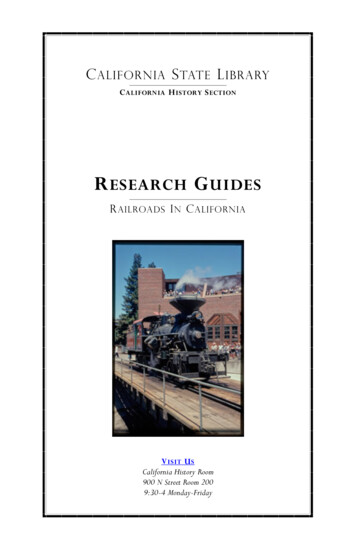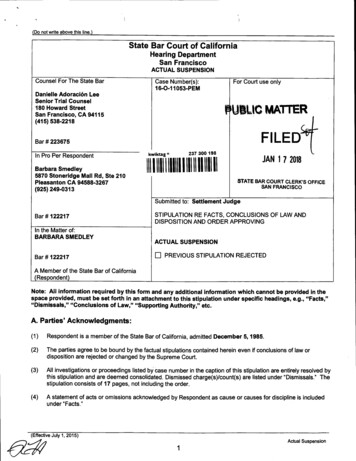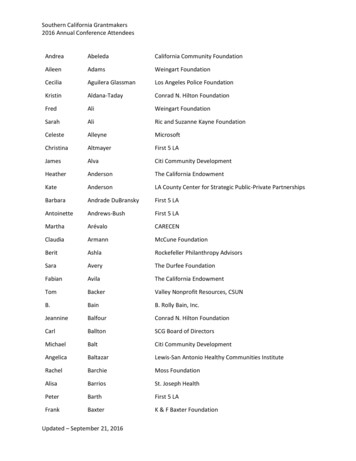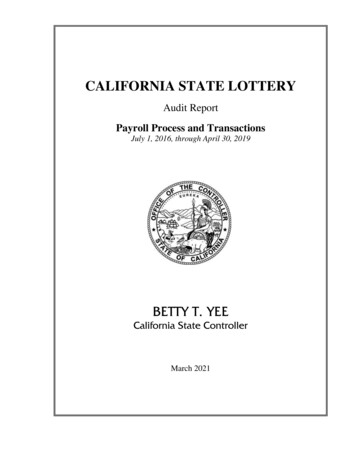
Transcription
CALIFORNIA STATE LOTTERYAudit ReportPayroll Process and TransactionsJuly 1, 2016, through April 30, 2019BETTY T. YEECalifornia State ControllerMarch 2021
BETTY T. YEECalifornia State ControllerMarch 1, 2021Alva Vernon Johnson, DirectorCalifornia State Lottery700 North Tenth StreetSacramento, CA 95811Dear Mr. Johnson:The State Controller’s Office audited the California State Lottery’s (Lottery) payroll process andtransactions for the period of July 1, 2016, through April 30, 2019. The purpose of the audit wasto determine if the Lottery maintains an adequate system of internal controls over its payrollprocess and processed payroll and payroll-related disbursements and leave balances accuratelyand in accordance with collective bargaining agreements and state laws, regulations, policies,and procedures.Our audit found that the Lottery lacked adequate segregation of duties and compensatingcontrols over the payroll process, resulting in improper and questioned payments; grantedinappropriate keying access to the State’s payroll system; did not implement adequate controls tolimit excessive leave balances; and did not properly administer salary advances.If you have any questions, please contact Mr. Finlayson by telephone at (916) 324-6310 or byemail at afinlayson@sco.ca.gov.Sincerely,Original signed byMICHAEL REEVES, CPAActing Chief, Division of AuditsJLS/as
Alva Vernon Johnson, Director-2-cc: Gregory Ahern, ChairCalifornia State Lottery CommissionNathaniel Kirtman III, CommissionerCalifornia State Lottery CommissionKeetha Mills, CommissionerCalifornia State Lottery CommissionPeter Stern, CommissionerCalifornia State Lottery CommissionHarjinder Chima, Chief Deputy DirectorCalifornia State LotteryChristopher Fernandez, Deputy Director, Human Resources DivisionCalifornia State LotteryJames Shannon, Audit Manager, Internal AuditsCalifornia State LotteryBrenden Murphy, Chief, Administrative Services DivisionCalifornia Department of Human ResourcesJil Barraza, Chief, Personnel and Payroll Services DivisionState Controller’s OfficeMarch 1, 2021
California State LotteryPayroll Process and Transactions AuditContentsAudit ReportSummary .1Background.1Objectives, Scope, and Methodology .2Conclusion.3Follow-Up on Prior Audit Findings .5Views of Responsible Officials .5Restricted Use .5Schedule—Summary of Audit Findings .6Findings and Recommendations .7Appendix—Statistical Sampling MethodologyAttachment—California State Lottery’s Response to Draft Audit Report
California State LotteryPayroll Process and Transactions AuditAudit ReportSummaryThe State Controller’s Office (SCO) audited the California State Lottery’s(Lottery) payroll process and transactions for the period of July 1, 2016,through April 30, 2019. The purpose of the audit was to determine if theLottery maintains an adequate system of internal controls over its payrollprocess and processed payroll and payroll-related disbursements and leavebalances accurately and in accordance with collective bargainingagreements and state laws, regulations, policies, and procedures.Our audit found that the Lottery lacked adequate segregation of duties andcompensating controls over the payroll process, resulting in improper andquestioned payments; granted inappropriate keying access to the State’spayroll system; did not implement adequate controls to limit excessiveleave balances; and did not properly administer salary advances. Furtherdetails of these findings are described in the Conclusion, and Findings andRecommendations sections of this report.BackgroundOn November 6, 1984, California voters passed Proposition 37, theCalifornia State Lottery Act of 1984 (Lottery Act), which authorized thecreation of a state-operated lottery. The Lottery Act is found inChapter 12.5, section 8880 et seq., of the Government Code. The LotteryAct created the California State Lottery Commission (Commission) andgave it broad powers to oversee the Lottery’s operations. The purpose ofthe Lottery Act is to provide supplemental money to benefit publiceducation without the imposition of additional or increased taxes.The Lottery has eight divisions: Executive, Finance, Human Resources,Operations, Public Affairs and Communications, Security and LawEnforcement, Information Technology Services, and Sales and Marketing.As of October 1, 2020, the Lottery has 909 budgeted positions; staff arelocated at Lottery Headquarters, two distribution centers, and nine districtoffices.In 1979, the State of California adopted collective bargaining for stateemployees. This created a significant workload increase for the SCO’sPersonnel and Payroll Services Division (PPSD), as PPSD was the State’scentralized payroll processing center for all payroll-related transactions.PPSD decentralized the processing of payroll, allowing state agencies anddepartments to process their own payroll-related transactions. TheLottery’s Transactions and Payroll Unit in the Human Resources Divisionhas the responsibility of processing personnel transactions, payroll, leavebalances, and benefits.Pursuant to Government Code (GC) section 8880.46.6, the SCO mayconduct special post-audits of the Lottery, as the State Controller deemsnecessary. The Controller or his/her agents conducting an audit under thischapter shall have access and authority to examine any and all records ofthe Commission.-1-
California State LotteryPayroll Process and Transactions AuditGC section 12410 states, in part:The Controller shall superintend the fiscal concerns of the state. TheController shall audit all claims against the state, and may audit thedisbursement of any state money, for correctness, legality, and forsufficient provision of law for payment.In addition, GC section 12411 stipulates that “ . . . the Controller shallsuggest plans for the improvement and management of revenues.”Furthermore, GC section 12476 states, “The Controller may audit theuniform state pay roll system, the State Pay Roll Revolving Fund, andrelated records of state agencies within the uniform State’s payroll system,in such manner as the Controller may determine.”Objectives, Scope,and MethodologyThe objectives of the audit to were to determine whether the Lottery: Maintained adequate and effective internal controls over its payrollprocess; Processed payroll and payroll-related disbursements and leavebalances accurately and in accordance with collective bargainingagreements and state laws, regulations, policies, and procedures; and Administered salary advances in accordance with collectivebargaining agreements and state laws, regulations, policies, andprocedures.The audit period was July 1, 2016, through April 30, 2019.To achieve our audit objectives, we: Reviewed State and the Lottery’s policies and procedures related tothe payroll process to understand the Lottery’s methodology forprocessing various payroll and payroll-related transactions; Interviewed the Lottery’s payroll personnel to gain an understandingof the Lottery’s internal controls and methodology for processingpayroll and payroll-related transactions; Selected the following transactions recorded in the State’s payrolldatabase using statistical sampling (see the Appendix), judgmentalselection, and targeted selection based on risk factors and otherrelevant criteria:o11 employees with keying access to the State’s payroll system;o45 out of 25,977 ( 226,378 out of 131,774,771) regular paytransactions;o129 out of 1,639 ( 251,601 out of 1,072,513) overtimetransactions;o66 out of 133 ( 948,295 out of 1,532,296) lump sumtransactions;-2-
California State LotteryPayroll Process and Transactions Audito115 out of 3,615 ( 230,165 out of 6,886,700) 9G bonus paytransactions;o34 out of 1,216 ( 16,704 out of 331,789) holiday credit accrualtransactions;o31 out of 69 ( 480,624 out of 903,755) excess vacation andannual leave balances;oFive out of 237 ( 38,628 out of 1,500,000) G1 paymenttransactions; Analyzed and tested the selected transactions, and reviewed relevantfiles and records to determine the accuracy of payroll and payrollrelated payments, accuracy of leave transactions, adequacy andeffectiveness of internal control over the payroll process, andcompliance with collective bargaining agreements and state laws,regulations, policies, and procedures; and Reviewed all eight ( 10,935) salary advance transactions to determinewhether the Lottery administered and recorded them in accordancewith collective bargaining agreements and state laws, regulations,policies, and procedures.We conducted this performance audit in accordance with generallyaccepted government auditing standards. Those standards require that weplan and perform the audit to obtain sufficient, appropriate evidence toprovide a reasonable basis for our findings and conclusions based on ouraudit objectives. We believe that the evidence obtained provides areasonable basis for our findings and conclusions based on our auditobjectives. We limited our review of internal control to gain anunderstanding of the Lottery’s payroll processes. We did not audit theLottery’s financial statements.ConclusionOur audit determined that the Lottery: Did not maintain adequate and effective internal controls over itspayroll process. We found the following deficiencies in internalcontrol over the payroll process that we consider to be materialweaknesses:1o1Inadequate segregation of duties and compensating controls overpayroll transactions (see Finding 1);A deficiency in internal control over compliance exists when the design or operation of a control does not allowmanagement or employees, in the normal course of performing their assigned functions, to prevent, or detect andcorrect, noncompliance with provisions of laws, regulations, or contracts on a timely basis. Control deficiencies,either individually or in combination with other control deficiencies, may be evaluated as significant deficienciesor material weaknesses. A material weakness in internal control over compliance is a deficiency, or combinationof deficiencies, in internal control over compliance, such that there is a reasonable possibility that materialnoncompliance with provisions of laws, regulations, or contracts will not be prevented, or detected and corrected,on a timely basis. A significant deficiency over compliance is a deficiency, or a combination of deficiencies, ininternal control over compliance with provisions of laws, regulations, or contracts that is less severe than amaterial weakness, yet important enough to merit attention from those charged with governance.-3-
California State LotteryPayroll Process and Transactions Audit oInappropriate keying access to the State’s payroll system (seeFinding 2);oFailure to implement controls to limit the accumulation ofvacation and annual leave balances, resulting in liability forexcessive balances (see Finding 3);oInadequate controls to ensure that separation lump-sum paymentswere calculated correctly and paid in a timely manner, resulting inimproper and late payments (see Finding 4);oInadequate controls to ensure that overtime payments werecalculated correctly, supported, and granted to eligible employees,resulting in improper and questioned payments (see Finding 5);oInadequate controls to ensure that bonus payments werecalculated correctly and granted to eligible employees, resultingin improper payments (see Finding 6);oInadequate controls to ensure that holiday credits were granted toeligible employees and supported with documentation, resultingin improper and questioned credits (see Finding 7); andoInadequate controls to ensure collection of salary advances in atimely manner, resulting in failure to recover outstanding amounts(see Finding 8).Did not process payroll and payroll-related disbursements and leavebalances accurately and in accordance with collective bargainingagreements and state laws, regulations, policies, and procedures. Wefound the following instances of noncompliance:oExcessive vacation and annual leave balances with a value of atleast 903,755 as of March 31, 2019 (see Finding 3).Although an October 20, 2020 directive from the CaliforniaDepartment of Human Resources (CalHR) does not affect thedollar value of this finding, we are disclosing this directivebecause it affects our recommendation. CalHR has directeddepartments to immediately suspend policies that require leavebalances to be reduced below the limit, and that require employeesto implement leave-reduction plans. This suspension will be ineffect until the 2020 Personal Leave Program (2020 PLP) ends orJuly 1, 2022, whichever is sooner;o Improper and late payments made for employee separation lumpsum pay (see Finding 4), improper and questioned payments madefor overtime pay (see Finding 5), improper payments made forbonus pay (see Finding 6); and improper and questioned holidaycredits (see Finding 7), costing an estimated net total of 127,477(see Findings 4, 5, 6, and 7); andDid not administer salary advances in accordance with collectivebargaining agreements and state laws, regulations, policies, andprocedures for three salary advances, totaling 2,500 that remainedoutstanding as of April 30, 2019 (see Finding 8).See the Schedule for a summary of the audit findings.-4-
California State LotteryPayroll Process and Transactions AuditFollow-Up on PriorAudit FindingsThe SCO previously performed an audit of the Lottery’s payroll processfor the period from July 1, 2012, through June 30, 2015, and issued a reporton February 24, 2017. The audit report included findings regarding keyingaccess, lump-sum payments, and overtime. Based on the work performedduring our current audit, we noted similar findings (see Findings 2, 4,and 5).Views ofResponsibleOfficialsWe issued a draft audit report on November 3, 2020. Alva VernonJohnson, Director, responded by letter dated November 16, 2020(Attachment), agreeing with the audit results. This final audit reportincludes the Lottery’s response.Restricted UseThis report is intended for the information and use of the Lottery, theCommission, CalHR, and the SCO; it is not intended to be and should notbe used by anyone other than these specified parties. This restriction is notintended to limit distribution of this report, which is a matter of publicrecord, and is available on the SCO website at www.sco.ca.gov.Original signed byMICHAEL REEVES, CPAActing Chief, Division of AuditsMarch 1, 2021-5-
California State LotteryPayroll Process and Transactions AuditSchedule—Summary of Audit FindingsAudit Area TestedMethod of SelectionSegregation of dutiesSystem accessExcess vacation and annual leaveSeparation lump-sum payOvertime pay9G bonus payHoliday creditSalary advancesTotalN/ATargetedStatisticalStatistical and targetedStatistical and targetedStatistical and targetedTargetedTargetedNumber ofUnits ofPopulationN/A11691331,6393,6151,2168Dollar Amountof Population 10,737,988-6-Number TransactionTransactionDollar Amountof SelectionsExaminedTotal DollarAmount ofKnown andLikely 8,324903,75569133,39580,22213,1692,5001,033,732 FindingNumber12345678
California State LotteryPayroll Process and Transactions AuditFindings and RecommendationsFINDING 1—Inadequatesegregation ofduties andcompensatingcontrols overpayrolltransactionsThe Lottery lacked segregation of duties within its Transactions andPayroll Unit to ensure that only valid and authorized payroll transactionswere processed. The Lottery also failed to implement other controls tocompensate for this risk.GC sections 13400 through 13407 require state agencies to establish andmaintain internal controls, including proper segregation of duties and aneffective system of internal review. Adequate segregation of dutiesreduces the likelihood that fraud or error will remain undetected byproviding for separate processing by different individuals at various stagesof a transaction and for independent reviews of the work performed.Our audit found that Transactions and Payroll Unit staff performedconflicting duties. Staff members performed multiple steps in processingpayroll transactions, including entering data into the State’s payrollsystem; auditing employee timesheets; reconciling payroll, includingreconciling system output to source documentation; reporting payrollexceptions; and processing adjustments. For example, staff memberskeyed in regular and overtime pay and reconciled the master payroll,overtime, and other supplemental warrants. The Lottery did not havecompensating controls, such as a periodic supervisory review, to mitigatethe risks associated with such a deficiency.The lack of adequate segregation of duties and compensating controls hasa pervasive effect on the Lottery payroll process, and impairs theeffectiveness of other controls by rendering their design ineffective or bykeeping them from operating effectively. These control deficiencies, incombination with other deficiencies discussed in Findings 2 through 8,represent a material weakness in internal control over the payroll processsuch that there is a reasonable possibility that noncompliance withprovisions of laws, regulations, or contracts will not be prevented, ordetected and corrected, on a timely basis.Good internal control practices require that the following functional dutiesbe performed by different work units, or at minimum, by differentemployees within the same unit: Recording transactions – This duty refers to the record-keepingfunction, which is accomplished by entering data into a computersystem. Authorization to execute – This duty belongs to individuals withauthority and responsibility to initiate and execute transactions. Periodic review and reconciliation of actual payments to recordedamounts – This duty refers to making comparisons of information atregular intervals and taking action to resolve differences.-7-
California State LotteryPayroll Process and Transactions AuditRecommendationWe recommend that the Lottery: Separate conflicting payroll function duties to the greatest extentpossible. Adequate segregation of duties will provide a strongersystem of internal control whereby the functions of each employee aresubject to the review of another.If it is not possible to segregate payroll functions fully andappropriately, the Lottery should implement compensating controls.For example, if the Transactions and Payroll Unit staff memberresponsible for recordkeeping also performs a reconciliation process,then the supervisor should perform and document a detailed review ofthe reconciliation to provide additional control over the assignment ofconflicting functions. Compensating controls may also include dualauthorization requirements and documented reviews of payroll systeminput and output; and FINDING 2—Inappropriatekeying access tothe State’s payrollsystemDevelop formal procedures for performing and documentingcompensating controls.The Lottery lacked adequate contr
California State Lottery Act of 1984 (Lottery Act), which authorized the creation of a state-operated lottery. The Lottery Act is found in Chapter 12.5, section 8880 et seq., of the Government Code. The Lottery Act created the California State Lottery Commission (Commission) and gave it broad pow
